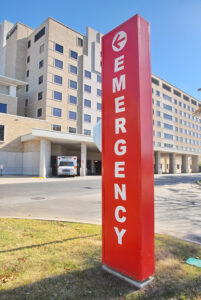
Updated 1/5/2023
1. Emergency room medical providers are held to the same standards of care as other doctors and care givers.
Emergency rooms are busy places where very important decisions are made. The emergency room team is made up of emergency physicians, nurses and other health care providers who decide whether a patient gets immediate testing, admission to the hospital, or waits for hours with no meaningful treatment. This team has a responsibility to stabilize the patient, diagnose a patient’s condition or injury, request evaluation by specialists, determine what treatment a patient needs, and how quickly that treatment must be rendered.
Every year, however, hundreds of people are sent home from hospital emergency rooms only to die or suffer serious permanent injury from the very ailment they complained of to the hospital emergency room. In these cases the failure of the emergency room doctors and medical personnel to properly diagnose and treat the ailment may be a result of substandard care.
Emergency room providers are held to the same standards as other doctors and care givers. These care givers are liable when their care falls below accepted standards. The standard of care is defined as what a similar health care provider would do under similar circumstances. Proper treatment may require an emergency room physician to order testing such as an electro cardiogram (EKG), MRI, CT scan, or other testing, or to request that specialists such as a cardiologist or neurologist evaluate the patient.
Read Mr. Filan’s medical malpractice success stories
2. To prevail in a medical malpractice case involving medical care rendered in an emergency department the patient must prove that a competent doctor under similar circumstances would not have made the same mistake — this is called negligence.
Emergency department negligence occurs when the doctors and nurses in question don’t pay enough attention, ignore the patient, or fail to order proper testing or consult with specialists. Doctors and nurses are individually liable for their own acts and omissions. Hospitals are liable for acts and omissions of their employees which may include nurses and emergency department physicians.
Hospitals may also be liable for the acts and omissions of private, non-employee physicians and other health care providers under agency theories. This is because the hospital provides the emergency physicians to the patient and the patient may not be aware that the emergency physician is an independent contractor who is not employed by the hospital.
3. Mistakes made in emergency rooms are just as grave as those made in calm situations.
Decisions in the emergency room are often of critical importance. Errors in the emergency department may carry grave consequences to the patient. Some examples of emergency department hospital malpractice cases our firm has handled include:
– Failure to diagnose and treat impending heart attack,
– Failure to diagnose and treat head injury such as subdural hematoma,
– Failure to diagnose and treat spinal cord injury,
– Failure to diagnose and treat perforated bowel, and
– Administration of improper medications.
The defense often argues that because the emergency room does not allow for the calm consideration available in other medical situations, a mistake must be fairly severe to rise to the level of negligence. A skilled malpractice trial attorney can defeat that defense by pointing out that a careful evaluation of the emergency patient is always required.
Read about medical malpractice attorney Patrick J. Filan
4. To be liable for medical malpractice, errors in the emergency department must be shown to have caused an injury and worsened the patient’s outcome.
To prevail in a medical malpractice case involving emergency department care there must be proof that had proper care been provided, the patient would not have suffered injury. It is not enough to show that the care rendered was substandard. If the outcome would have been the same then the patient cannot prevail.
For example it may be below the standard of care not to order a CT or MRI for a patient who arrives at the ER with a head injury. Such testing may offer valuable information to assess whether there is bleeding in the brain and whether an operation to relieve that bleeding is required. If a day or 2 after being discharged from the emergency department without either test the patient sees another doctor who orders a CT or MRI, finds bleeding in the brain, and performs the same operation that could have been performed earlier in the ER, then the substandard care rendered in the emergency department may not have altered the patient’s outcome or caused an injury.
5. First responders are protected by law against medical malpractice claims.
Connecticut, like most states, has a statute that protects the “first responders” to medical emergencies, including ambulance crews, firefighters, and emergency medical technicians. Connecticut’s Good Samaritan Law immunizes medical personnel, persons trained in cardiopulmonary resuscitation, railroad companies and employees, and other appropriate personnel from lawsuits for damages incurred while administering emergency medical aid.
Connecticut law also provides that a person licensed to practice medicine and surgery who “voluntarily and gratuitously” provides emergency medical care is not be liable for damages or personal injuries which result from acts or omissions by such person in rendering emergency care.
6. Emergency rooms can be held liable for medical malpractice by refusing to treat a patient.
Any hospital that receives Medicare funding (which most hospitals do) is subject to the rules of a federal law called the Emergency Medical Treatment and Active Labor Act (EMTALA). Under EMTALA, the emergency room cannot turn anyone away, regardless of the person’s ability to pay. Instead, the emergency room must provide a medical screening of the injured person, and stabilize the person to the extent possible.
Please contact attorney Patrick J. Filan in regards to medical practice in Connecticut and New York.
